
Report by Ahmed Fergiani 1
In 146 B.C., the Roman legions sacked Carthage and took over its wheat fields. Less than 25 years later, Rome was able to begin the distribution of grain to its citizens at subsidized prices, and later free of charge under the slogan Panem ET Circenses (bread and circuses) which became the unofficial solution for Romans to rule over the populations of nearly 50 modern states with different backgrounds, religions and languages. To make this possible and keep one million Romans who lived in Rome, fed and happy, ships had to leave Rome every week, if the weather cooperated. They sailed the sea in large convoys to get the necessary grain.
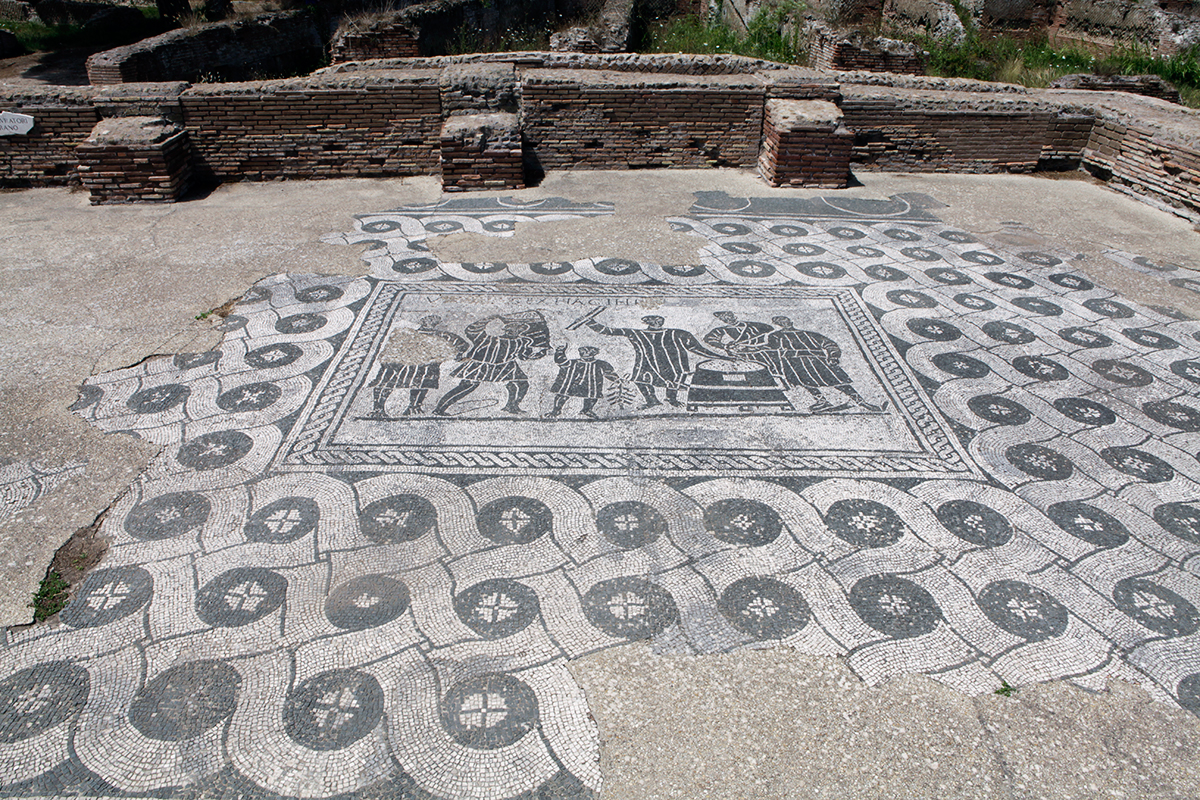
The crossing from Alexandria, Egypt took 13 days; Sabratha in Libya four days and from Carthage three days. (see 'winter shipping').
Flavius Josephus, a Jewish Historian and general living in the first Century A.D wrote that every year Rome depended eight months on the grain supplied from the African provinces.
Was it just grain that these African provinces supplied to Rome and are there any remains of those African ports?
From sources we know that olive oil was highly appreciated by the Romans. The city of Leptis Magnum in Libya had to pay more than one million litres olive oil a year to Caesar because during the civil war raging from 49 till 45 BC, between Julius Caesar and Pompeius, Leptis took side with the looser (Pompeius).
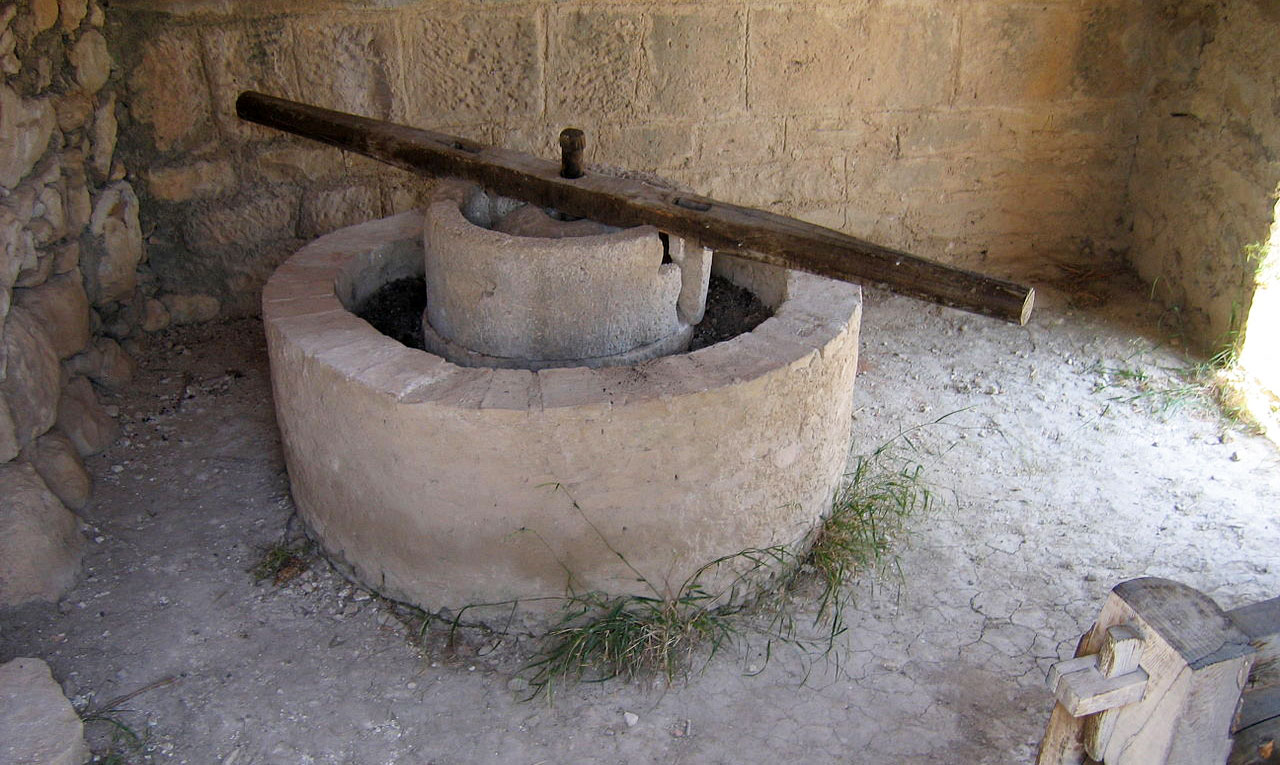
The remains of 58 different olive presses can still be seen today among the Roman ruins of Volubilis in Morocco. In this article we like to tell you more about the African harbours that had permanent stations in Ostia, the ancient harbour of Rome.
MAURETANIA CAESARIENSIS
The central and western part of modern Algeria was called Mauretania, a province of Rome divided by the emperor Claudius in the 1st century A.D. into two parts: Mauretania Caesariensis and Mauretania Tingitana (see 'The ports').
The most important city of the region was Caesarea, founded as the city Iol by the Phoenician in the 8th century B.C. Its modern name is Cherchall ( الشرشال ). The Roman city was the birthplace of the Roman Emperor Macrinus. He was emperor from the 11th of April 217 till the 8th of June 218 A.D
Caesarea in particular but also the other cities of the region like Tipasa, Cartenna (modern Ténès تنس ) and Pomaria (Tlemcen تْلمسان) abundantly produced olive oil, grains and dates as we see in the mosaics of Musée de Cherchell and we understand from their Ostian staziones.
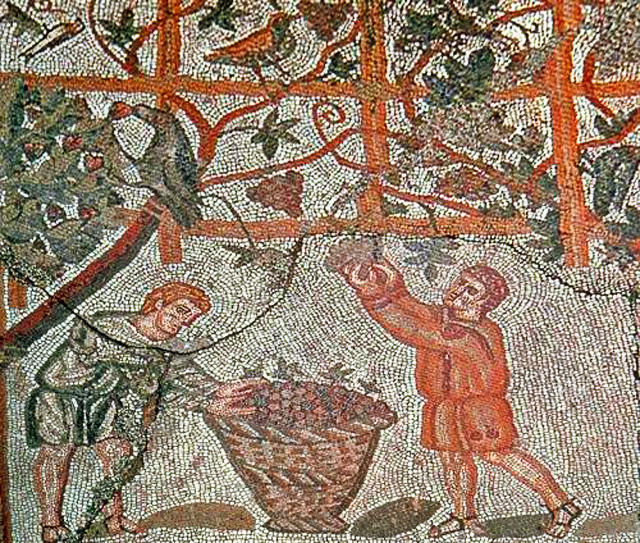
JULIA HIPPO DIARRYTHUS (بنزرت )
Hippo, today's Biserta in Northern Tunisia, was an ancient Phoenician settlement as is evident from its name and probably founded by the same Phoenicians who founded the nearby Utica. An ancient Greek historian added to Hippo the nickname Diarrhytus, which means: Divided by the water (in this case by the modern canal of Bizerte).
Under the name Hippo Diarrhytus, it became a Roman city after the defeat of Carthage, got the addition Julia and was raised to the colonial rank of the Roman Empire. The city lived its heydays thanks to the maritime trade with Rome mainly to its fisheries, wines and woods. Pliny The Younger mentioned Julia Hippo Diarrythus as 'a peaceful and beautiful colony, famous for its games and fishing.'
CURUBIS (قربة )
Curubis was originally a Punic port dating back to the 3rd century BC. Between the years 59-46 AC. the city was transformed into a Julian colony by Julius Caesar, eager to improve the transport of African grain to Rome. The oldest, still visible, archeological evidence of Curubis dating back to 45 BC. are some traces of water cisterns and a still visible part of an aqueduct. There have also been left an inscription from Curubis with the following text:4:
P . ATTIVS . P . F . VAARVS . LEG . PRO . PR
C . CONSIDIVS C.F.LONGVS . LEG . PRO. PR
MVRVM . TVRBES . POSTEICVVS
FOSSAM . FAVIVNDVM . COER
T . TETTIVS . T . F . VEL . PRAEFECTVS
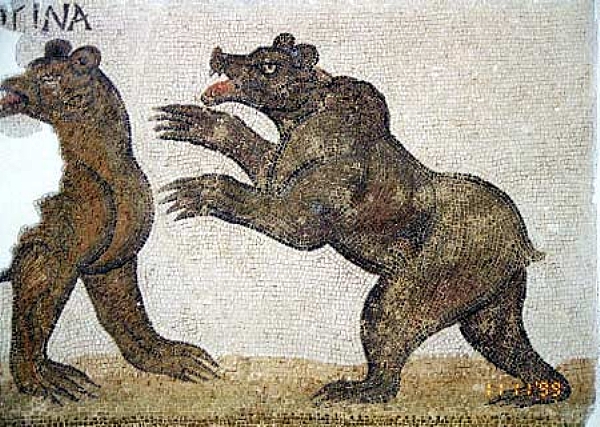
Several mosaics dating from the Roman period have been found and are all displayed at the museum of Bardo, like the famous Munus mosaic that shows a fight between wild animals.
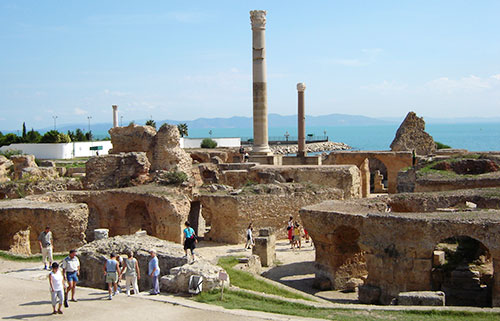
CARTHAGE (قرطاج )
According to an old legend, Carthage was founded by the cunning Phoenician princess Dido who fled Phoenicia and landed in North Africa around the year 814 BC. The local king liked her and offered her a piece of land as large as a bulls skin. She cut the skin in ribbons and put them behind each other. In that way she obtained a rather larger piece of land and founded on that land a city called Qart Hadašt (the new city = Carthage).
Two centuries later Carthage ruled eight nations until it was razed to the soil by the Romans in 146 BC. But Carthage never died completely! Taken its Phoenician heritage, its geographical position and its political colonial ambition, Carthage became one of the richest cities in the ancient world. Metals, foodstuffs, slaves, and high-quality manufactured goods such as pottery, the Carthaginians became renowned for their mercantile skills and ability to sell anything to anyone, but always at a price.
Carthage also was fairly advanced in agriculture and was a big exporter of grains, and famous for her horses, which strongly resemble the Arabian horses of today. Mago, a writer from Carthage, wrote a 28 volume treatise on agriculture and soil preservation, which was so highly valued all over the world , it was translated in Greek by Cassius Dionysius and afterwards, payed by the Roman senate, in Latin by Decimus Junius. The text of Dionysius as well as the latin text from Junius are lost. However, parts of Mago’s work were used by other writers, such as Plinius the Elder, in their own work and rescued from oblivion.
SYLLECTUM/DALAKTA (سلقطة )
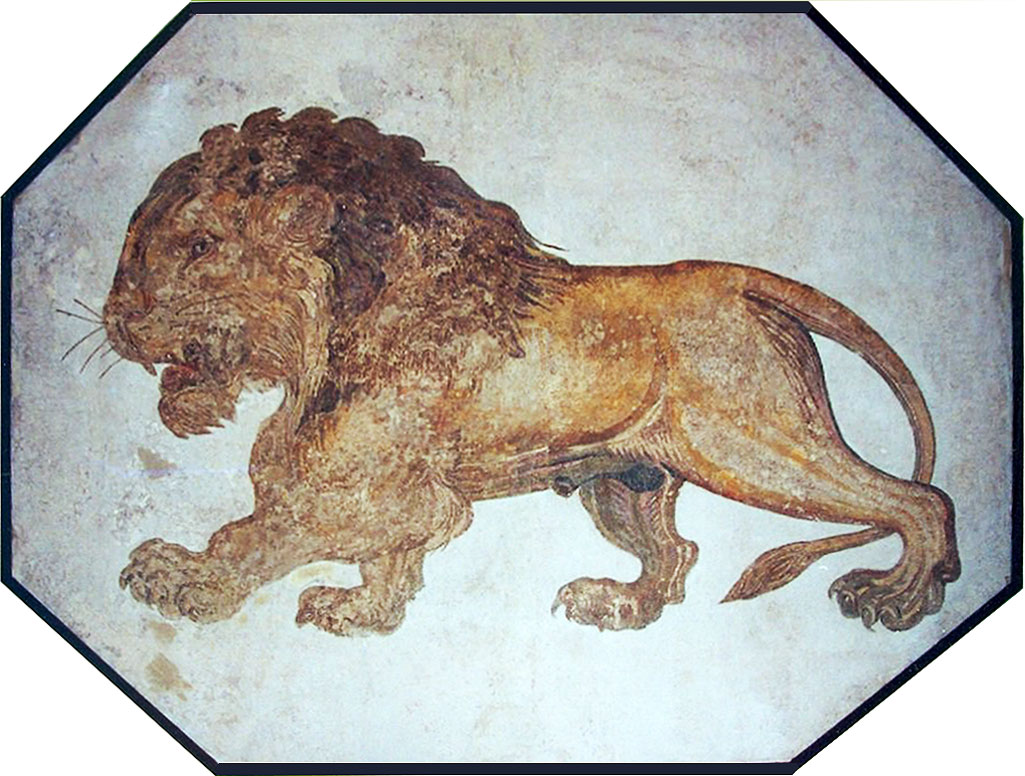
Because of its location 200 km south of Tunis, Syllectum was chosen by the Phoenicians as a secure port with a rich country side. When Rome defeated Carthage, Syllectum started to prosper exporting wheat, and later olive oils, garum and wines. Its port was successively busy and important and managed to be among the elite Roman cities to have a permanent trading post in Ostia.
Today not much is left of Salakta, as the majority of the city is under the sea. Archaeological excavations brought to light the famous mosaic of the African lion, also preserved at the museum of Bardo.
SABRATHA (صبراتة )
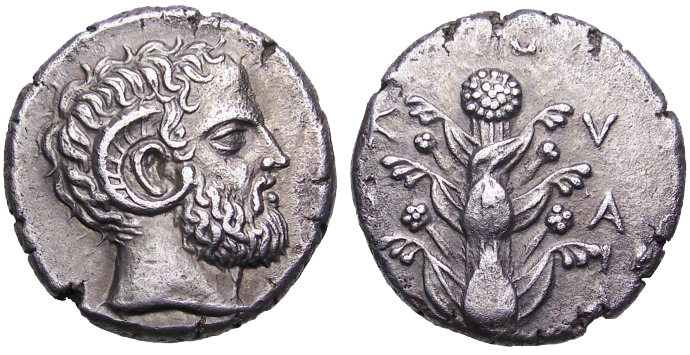
(4e century BC.)6
The Libyan coast provided among others olive oil, grain and cumin. The economy of Cyrenaica (Cyrene) in the east of Libya depended strong on Silphium (now extinct) from Cyrenaica. Silphium was so important that many coins depicted the plant.
But also other spices were exported as well as prized birds, such as the ostrich and the African chicken (guinea fowl). All these products were taken from the fringes of the desert and transported to the coastal ports of Leptis Magna, Apollonia and Sabratha.
Sabratha was founded in the 5th century B.C as a Punic harbour called SBRTN at the location of a small natural harbour ideal for ships sailing the Mediterranean Sea. Later on, under the Carthaginians and the Romans, it became a real town.
The city testified a famous historical event. In 158 AD, Apuleius, a Latin writer from Madaura, ended his defence against a court of magistrates under the supervision of the proconsul in the basilica of Sabratha as he was charged for having forced a rich widow with sorcery into marrying him. His defence (Apologia) has become the most hilarious work in which he makes his opponents utterly ridiculous. It is one of the most funniest stories that has come down from antiquities.
Sabratha was the final destination of the caravan route that brought ivory, wild animals and slaves from Central Africa through Garama جرمة and Ghadamis غدامس , along with the grain which was abundant in its hinterland. These exports made Sabratha a prosperous Roman port city.
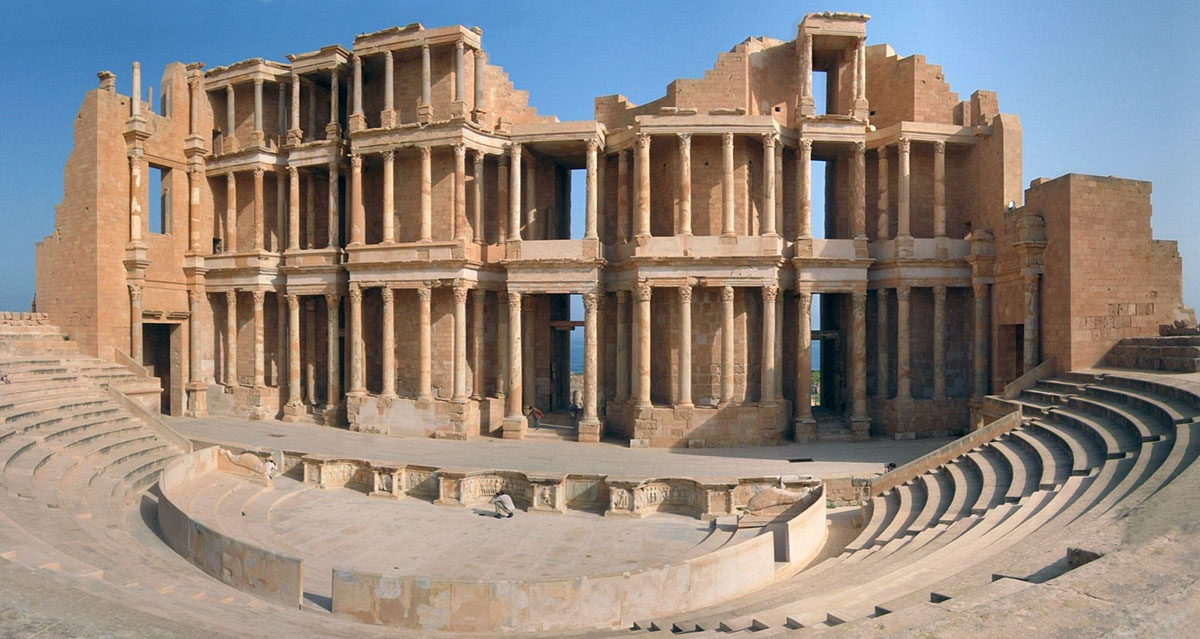
ALEXANDRIA (الاسكندرية )
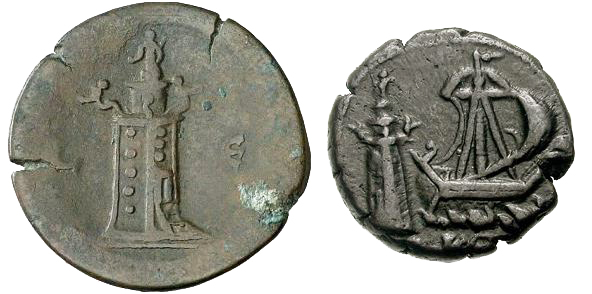
According to the Roman author Vitruvius Alexandria had three ports, probably built between 300 and 250 BC during the Hellenistic period.
Roman Alexandria became the breadbasket of Rome as it was famous not just for the gains and papyrus but also for its lobsters, while the African snail (Afra coclea) was praised by the poet Horace as suited to the delicate digestion of epicures. Pliny provided a recipe for the African snails: “Simmer, under water, then, without flavoring, roast on hot coals. Take with wine and fish sauce.” Apicius provided a recipe for stuffed gourds “Alexandria style,” with a filling of ground pine-nuts, date, wine, honey, vinegar, cumin, coriander seed, and other ingredients (3,IV,3). He also had three fish recipes “Alexandria style,” using ingredients like raisins, vinegar, and garum.
Alexandria not only exported to Rome the mentioned goods but also wild animals brought from Sudan and red granite columns from Aswan in southern Egypt.
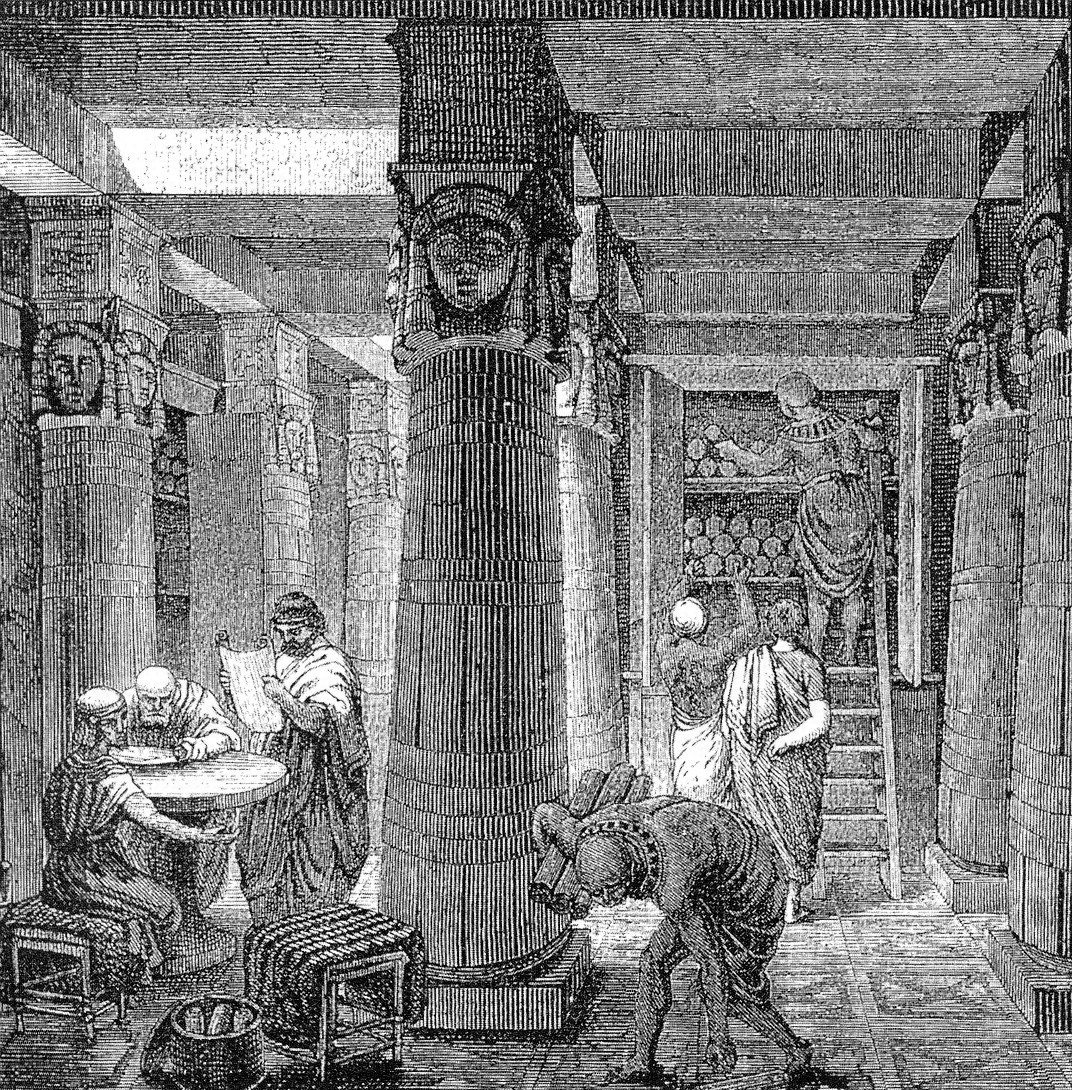
- notes:
- 1: Gerard.1.Rickman, G.E(1980). ''The Grain Trade Under the Roman Empire''.Memories from the American academy and David Abulafia the great sea 2011. Trade,commerce and the state in the Roman world.page 267 ALAN BOWMAN
- 2:photo: href="https://www.flickr.com/photos/edoug/827586924/"
- 3:photo: User:JPS68
- 4: transription: P(ublius) Attius P(ubli) f(ilius) Vaarus(!) leg(atus) pro pr(aetore) / C(aius) Considius C(ai) f(ilius) Longus leg(atus) pro pr(aetore) / murum turres post{e}icuus(!) / fossam faciundum coer(averunt) / T(itus) Tettius T(iti) f(ilius) Vel(ina) praefectus
- 5:photo: BishkekRocks
- 6:photo: Kyrenaica, Kyrene AR Tetradrachm. Late 5th-4th Century BC. Head of Zeus Ammon right / K-Y-P-A, silphium plant. Weber 8475, BMC 69; McClean 9936, pl.375, 3. 13.25g, 25mm, 12h.
- 7:photo: Marku1988
- 8:photo: The Pharo of Alexandria (2e eeuw na Chr.) the first coin from Antoninus Pius time;de second coin from the time of Commodus
- 9:photo: Tolzmann, Don Heinrich, Alfred Hessel and Reuben Peiss. The Memory of Mankind. New Castle, DE: Oak Knoll Press, 2001






 We are committed to providing versions of our articles and interviews in several languages, but our first language is English.
We are committed to providing versions of our articles and interviews in several languages, but our first language is English.